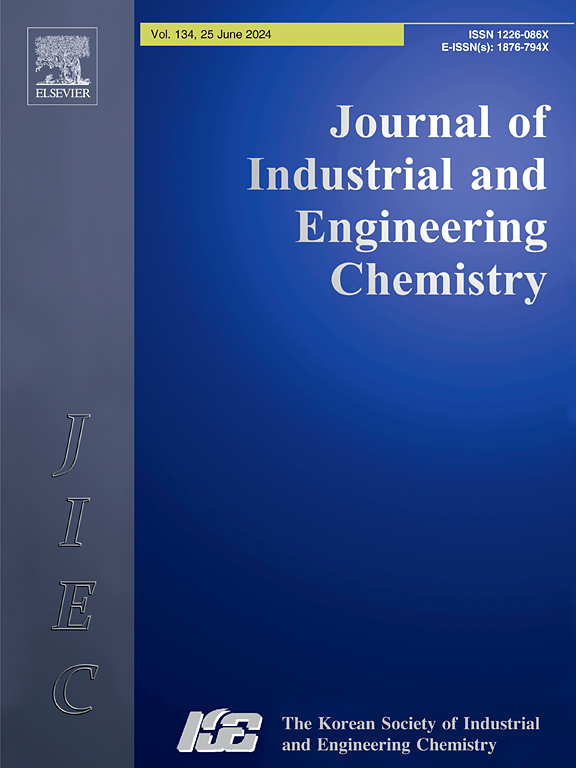Enhanced adsorption of Pb(II) ions using a magnetic mesoporous molecular sieves derived from coal fly ash and Nano-Fe3O4 particles
IF 5.9
3区 工程技术
Q1 CHEMISTRY, MULTIDISCIPLINARY
Journal of Industrial and Engineering Chemistry
Pub Date : 2024-11-28
DOI:10.1016/j.jiec.2024.11.053
引用次数: 0
Abstract
The synthesis of high-performance adsorption materials from coal fly ash presents a promising approach to mitigating environmental pollution in wastewater treatment processes. A novel magnetic mesoporous molecular sieve (MMS) was synthesized through hydrothermal methods utilizing coal fly ash and nano-Fe3O4 particles. The resultant MMS was characterized using XRD, FT-IR, SEM, TEM, and BET analysis. The adsorption performance of MMS for Pb(II) was evaluated by examining thermodynamic and adsorption models. The results show that MMS exhibited mesoporous structures with embedded Fe3O4 nanoparticles, possessing a surface area of 22.94 m2/g and a pore size of 28.47 nm, favorable for applications in aqueous adsorption. The adsorption behavior of Pb(II) onto MMS adhered well to both pseudo-first-order kinetic model and Langmuir isotherm, with a maximum adsorption capacity of 236.97 mg/L. Further insights into the adsorption mechanism were provided by zeta potential and XPS analysis, which revealed that lead is effectively adsorbed onto MMS, with the lead existing predominantly in the form of oxides on the MMS surface. The adsorption process was primarily governed by physical adsorption, accompanied by chemical adsorption. This study presents an innovative approach to converting coal fly ash into highly efficient magnetic adsorbents, thereby offering a sustainable solution for wastewater treatment.
粉煤灰和纳米fe3o4磁性介孔分子筛对Pb(II)离子的增强吸附
利用粉煤灰合成高性能吸附材料是减轻废水处理过程中环境污染的一种可行方法。利用粉煤灰和纳米 Fe3O4 颗粒,通过水热法合成了一种新型磁性介孔分子筛(MMS)。利用 XRD、FT-IR、SEM、TEM 和 BET 分析对合成的 MMS 进行了表征。通过研究热力学和吸附模型,评估了 MMS 对铅(II)的吸附性能。结果表明,MMS 具有嵌入式 Fe3O4 纳米颗粒的介孔结构,比表面积为 22.94 m2/g,孔径为 28.47 nm,有利于在水吸附中的应用。Pb(II) 在 MMS 上的吸附行为符合伪一阶动力学模型和 Langmuir 等温线,最大吸附容量为 236.97 mg/L。zeta 电位和 XPS 分析进一步揭示了吸附机理,它们显示铅被有效地吸附在 MMS 上,铅主要以氧化物的形式存在于 MMS 表面。吸附过程主要是物理吸附,同时伴有化学吸附。这项研究提出了一种将粉煤灰转化为高效磁性吸附剂的创新方法,从而为废水处理提供了一种可持续的解决方案。
本文章由计算机程序翻译,如有差异,请以英文原文为准。
求助全文
约1分钟内获得全文
求助全文
来源期刊
CiteScore
10.40
自引率
6.60%
发文量
639
审稿时长
29 days
期刊介绍:
Journal of Industrial and Engineering Chemistry is published monthly in English by the Korean Society of Industrial and Engineering Chemistry. JIEC brings together multidisciplinary interests in one journal and is to disseminate information on all aspects of research and development in industrial and engineering chemistry. Contributions in the form of research articles, short communications, notes and reviews are considered for publication. The editors welcome original contributions that have not been and are not to be published elsewhere. Instruction to authors and a manuscript submissions form are printed at the end of each issue. Bulk reprints of individual articles can be ordered. This publication is partially supported by Korea Research Foundation and the Korean Federation of Science and Technology Societies.

 求助内容:
求助内容: 应助结果提醒方式:
应助结果提醒方式:


